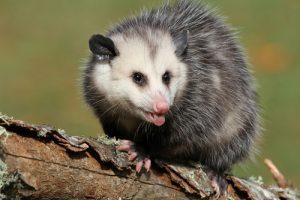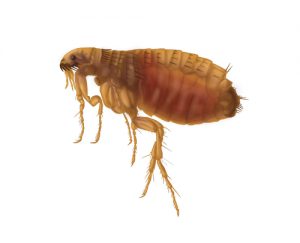Opossums & Fleas
By Chris Williams on July 8, 2011.
Q. An opossum got into the void space above the living room ceiling of our 200-year old home. A trapper we contacted got the mom and two babies out but didn’t know, or didn’t tell us, that there were more babies. The babies died, and then we had to put up with the horrible odor and blow flies. That’s mostly done with, but now we have fleas biting us. We can’t seem to get rid of them although I think we’re making a dent. We don’t have any pets so we figure the fleas came from the possums. Is that possible?
A. I’m afraid it is. Opossum are known as flea reservoirs, meaning that fleas that have been feeding on opossums can then infest pets that go outside. Once the baby possums died and there was nothing for the fleas to feed on, they moved into your living space looking for a blood meal. You’ve probably killed most of that initial flush of fleas but, unfortunately, there may be more to come as new adult fleas emerge.
 After the possums are gone, fleas will still continue to develop for some time. The larvae don’t even need blood; they feed on debris in the possums’ nest. They’ll continue to feed and then pupate. Fleas can then remain in the pupal stage for a considerable amount of time, even months, if there is not an animal available to feed on. When they sense heat, movement, or CO2, they are stimulated to emerge from the pupal cocoon as adult fleas. In other words, you could get waves of adult fleas appearing for some time.
After the possums are gone, fleas will still continue to develop for some time. The larvae don’t even need blood; they feed on debris in the possums’ nest. They’ll continue to feed and then pupate. Fleas can then remain in the pupal stage for a considerable amount of time, even months, if there is not an animal available to feed on. When they sense heat, movement, or CO2, they are stimulated to emerge from the pupal cocoon as adult fleas. In other words, you could get waves of adult fleas appearing for some time.
The only way to stop the appearance of new fleas is to remove or treat the nest area. Since it sounds like it may be difficult to access that area without tearing up the ceiling, injection treatment of the area is an option. A pest control company can inject a pesticide into that void space above the ceiling through a small opening.
 Your situation underscores the importance of using a company that does both nuisance wildlife trapping and general pest control. At Colonial, we are experts in both. Our pest control professionals always make sure that all of the young are removed with the mother. We also anticipate pest problems that can occur after animals are removed. Our technicians know that it’s important to remove or treat (if the nest can’t be reached) the nest so that fleas, mites, and lice from the animals and secondary invaders like flies and scavenger beetles do not bother the human inhabitants after the job is done. It’s not too late to give us a call!
Your situation underscores the importance of using a company that does both nuisance wildlife trapping and general pest control. At Colonial, we are experts in both. Our pest control professionals always make sure that all of the young are removed with the mother. We also anticipate pest problems that can occur after animals are removed. Our technicians know that it’s important to remove or treat (if the nest can’t be reached) the nest so that fleas, mites, and lice from the animals and secondary invaders like flies and scavenger beetles do not bother the human inhabitants after the job is done. It’s not too late to give us a call!